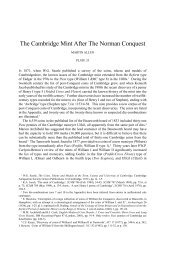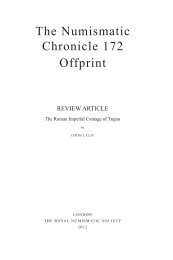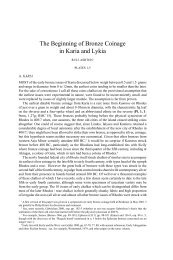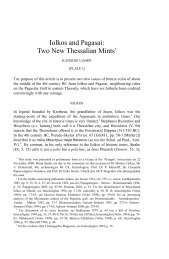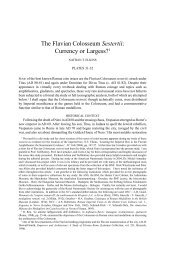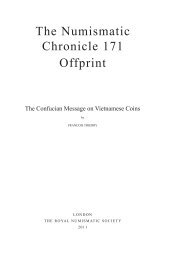The Numismatic Chronicle 171 Offprint - Royal Numismatic Society
The Numismatic Chronicle 171 Offprint - Royal Numismatic Society
The Numismatic Chronicle 171 Offprint - Royal Numismatic Society
You also want an ePaper? Increase the reach of your titles
YUMPU automatically turns print PDFs into web optimized ePapers that Google loves.
ROMAN REPUBLICAN STAR BRONZES, RRC 113 AND 196 103<br />
3. Wales meet in a short rostrum tridens which projects, if at all, only a bit past<br />
the hull.<br />
4. <strong>The</strong> A in ROM_ is open, i.e. the bar of the A is angled and is connected to only<br />
one of the two vertical supports of the letter .<br />
Fig. 7: Period 1 triens Fig. 8: Period 1 quadrans<br />
Omitted from this picture are the many poorer-style, lighter-weight quadrantes<br />
(Figs 12, 13 below) which so many experts have mentioned, and which have caused<br />
all the star-before fractions to be wrongly associated with Period 2 rather than<br />
Period 1.<br />
5. Features of fractional star-above bronzes – to be reclassifi ed with RRC 196<br />
Having established the Period 1 and 2 characteristics from the star asses and semisses,<br />
and noted that these agree with other contemporary bronze issues, e.g. Rostrum<br />
Tridens (RRC 114) for Period 1 and AT (RRC 192) for Period 2, let us now look at<br />
the lower fractions. Supposedly associated with Period 1, the triens, quadrans and<br />
sextans tell a different story. Examining fi rst the reverse style, we see the following<br />
(Figs 9, 10, 11, below):<br />
1. <strong>The</strong> prow-stem is short, fat and curved.<br />
2. <strong>The</strong> lower wale is always equidistant from the upper wale and the keel, even<br />
when this distance diminishes over the length of the keel.<br />
3. Wales do not meet but form a long rostrum tridens, projecting well past the<br />
hull.<br />
4. <strong>The</strong> A in ROMA is closed, i.e. the bar in the A is horizontal and connected to<br />
both the vertical supports of the letter.<br />
Although classifi ed by Crawford as Period 1, the star-above triens, quadrans and<br />
sextans differ consistently from Period 1 style, and exhibit the characteristics of<br />
Period 2. Clearly they must be associated with RRC 196 rather than with RRC 113,<br />
in correction of the view of d’Ailly and Crawford.<br />
Fig. 9: Period 2 triens Fig. 10: Period 2 quadrans Fig. 11: Period 2 sextans



